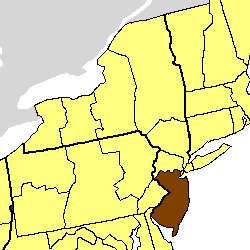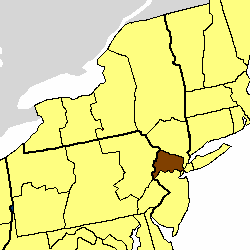Trinity Church is a historic parish in the Episcopal Diocese of New York, whose church is located at 89 Broadway opposite Wall Street, in the Financial District of Lower Manhattan in New York City. Known for its centuries of history, prominent location, distinguished architecture and bountiful endowment, Trinity's congregation is said to be "high church", its activities based on the traditions of the Episcopal Church and the worldwide Anglican Communion in missionary outreach, and fellowship. In addition to its main church, Trinity parish maintains two chapels: St. Paul's Chapel, and the Chapel of St. Cornelius the Centurion on Governors Island. The Church of the Intercession, the Trinity Chapel Complex and many other of Manhattan's Anglican congregations were once part of Trinity parish. Columbia University was founded on the church's grounds as King's College in 1754.

St. Bartholomew's Church, commonly called St. Bart's, is a historic Episcopal parish founded in January 1835, and located on the east side of Park Avenue between 50th and 51st Street in Midtown Manhattan, in New York City. In 2018, the church celebrated the centennial of its first service in its Park Avenue home.

Grace Church is a historic parish church in Manhattan, New York City which is part of the Episcopal Diocese of New York. The church is located at 800–804 Broadway, at the corner of East 10th Street, where Broadway bends to the south-southeast, bringing it in alignment with the avenues in Manhattan's grid. Grace Church School and the church houses—which are now used by the school—are located to the east at 86–98 Fourth Avenue between East 10th and 12th Streets. In 2021, it reported 1,038 members, average attendance of 212, and $1,034,712 in plate and pledge income.

The Episcopal Diocese of New Jersey forms part of Province II of the Episcopal Church in the United States of America. It is made up of the southern and central New Jersey counties of Union, Middlesex, Somerset, Hunterdon, Mercer, Monmouth, Ocean, Burlington, Camden, Atlantic, Gloucester, Salem, Cumberland, and Cape May. It is the second oldest of the nine original Dioceses of the Episcopal Church. Services began in 1685 at St. Peter's, Perth Amboy, the oldest parish in the diocese. The diocese itself was founded in 1785.

The Episcopal Diocese of Newark is a diocese of the Episcopal Church in the United States of America comprising the northern third of New Jersey in the United States. The Diocese represents the Anglican Communion, of which the Episcopal Church is a province, and presides over Episcopal parishes, missions, outreach ministries and schools in the New Jersey counties of Bergen, Essex, Hudson, Morris, Passaic, Sussex, Warren, and one church in Union County.

St. Michael's Church is a historic Episcopal church at 225 West 99th Street and Amsterdam Avenue on Manhattan's Upper West Side in New York City. The parish was founded on the present site in January 1807, at that time in the rural Bloomingdale District. The present limestone Romanesque building, the third on the site, was built in 1890–91 to designs by Robert W. Gibson and added to the National Register of Historic Places in 1996.

The Church of Saint Mary the Virgin is an Episcopal Anglo-Catholic church in Midtown Manhattan, New York City, which is part of the Episcopal Diocese of New York of the Episcopal Church in the United States of America. The church complex is located in the heart of Times Square at 133-145 West 46th Street, with other buildings of the complex at 136-144 West 47th Street, between Sixth and Seventh Avenues. It is colloquially known as "Smoky Mary's" because of the amount of incense used in the services.

Grace Church in Newark (Episcopal) is an active and historic Episcopal Church in the Diocese of Newark. It is located on Newark, New Jersey's Broad Street where it has stood since 1837. Grace is a traditional church that worships in the Anglo-Catholic tradition. Grace is notable for its architecture, music, and as the birthplace of the tune "America the Beautiful".

Calvary Episcopal Church is one of the largest Episcopal congregations in New Jersey. It belongs to the Episcopal Diocese of Newark of the Episcopal Church in the United States of America, a member of the Anglican Communion.
William Halsey Wood was an American architect.

St. Stephen's Episcopal Church, in Beverly, Burlington County, New Jersey, United States, is located on the corner of Warren and Wilmerton streets in Beverly. While the St. Stephen's community worshipped at the site beginning in 1837, the current church building was consecrated in 1855 and the rector presently serving the congregation is Fr. Robert Legnani.

Church of St. Thomas the Apostle is a former Roman Catholic parish church in New York City that had been threatened with demolition. It was the subject of a landmarks preservation debate. The parish was established in 1889; staffed by the Salesians of Don Bosco from 1979 to 2003; and closed in 2003 because of a diminished congregation and structural problems.

St. Joseph Catholic Church is a former Catholic parish in the Diocese of Davenport. Its former parish church is located in the west end of Davenport, Iowa, United States. It was listed on the National Register of Historic Places in 1983. The church and the rectory were listed together on the Davenport Register of Historic Properties in 1999. After serving as the location of a Reformed Baptist congregation and a private elementary school named Marquette Academy, the parish property now houses an evangelical Christian ministry named One Eighty.

Bergen Hill is the name given to the emergence of the Hudson Palisades along the Bergen Neck peninsula in Hudson County, New Jersey and the inland neighborhood of Jersey City, New Jersey, where they rise from the coastal plain at the Upper New York Bay. The name is taken from the original 17th-century New Netherland settlement of Bergen, which in Dutch means hills.

The Church of the Holy Communion is a historic Episcopal church building on Summit Street in Norwood, Bergen County, New Jersey, United States.

St. John's Church is a historic Roman Catholic parish church located within the Archdiocese of Newark at 22-26 Mulberry Street in Newark, Essex County, New Jersey, United States. St. John's Church is the state's third-oldest Catholic church.

St. Mark's Episcopal Church is a historic church located at 13 Main Street at Valley Road in West Orange, Essex County, New Jersey, United States. After the Episcopal congregation dwindled, the building subsequently housed the Primera Iglesia Evangelica Metodista Libra de los Oranges, a Methodist congregation. The building's interior was destroyed, and exterior badly damaged, by fire on January 1, 2016.

Trinity & St. Philip's Cathedral is a historic church located at Broad and Rector Streets in Military Park in the city of Newark in Essex County, New Jersey, United States. It is the seat of the Episcopal Diocese of Newark. The church building was added to the National Register of Historic Places on November 3, 1972, for its significance in architecture and religion. It was added as a contributing property to the Military Park Commons Historic District on June 18, 2004.

Christ Church, also known as Christ Episcopal Church, is a Christian house of worship located on the corner of Church Street and Main Street in Newton, New Jersey. It is a parish overseen by the Episcopal Diocese of Newark, a diocese of the Episcopal Church in the United States of America. The congregation first met on 28 December 1769 and was granted a charter by New Jersey's last Royal Governor William Franklin on behalf of Britain's King George III. Christ Church is the oldest church in Newton and the third oldest parish in the Diocese of Newark.

St. Peter's Episcopal Church is an active and historic Episcopal church in the Diocese of Newark in Morristown, New Jersey. Located on South Street, St. Peter's congregation has roots going back to the 1760s. Officially founded in 1827, with the current building consecrated in 1911, it is notable for its gothic-revival architecture, medieval interior and fine stained glass. St. Peter's congregation has traditionally worshipped in the High Church tradition. The church was added to the National Register of Historic Places, listed as a contributing property of the Morristown District, on October 30, 1973.



















